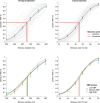A proxy measure of striatal dopamine predicts individual differences in temporal precision
- PMID: 35318580
- PMCID: PMC9436857
- DOI: 10.3758/s13423-022-02077-1
A proxy measure of striatal dopamine predicts individual differences in temporal precision
Abstract
The perception of time is characterized by pronounced variability across individuals, with implications for a diverse array of psychological functions. The neurocognitive sources of this variability are poorly understood, but accumulating evidence suggests a role for inter-individual differences in striatal dopamine levels. Here we present a pre-registered study that tested the predictions that spontaneous eyeblink rates, which provide a proxy measure of striatal dopamine availability, would be associated with aberrant interval timing (lower temporal precision or overestimation bias). Neurotypical adults (N = 69) underwent resting state eye tracking and completed visual psychophysical interval timing and control tasks. Elevated spontaneous eyeblink rates were associated with poorer temporal precision but not with inter-individual differences in perceived duration or performance on the control task. These results signify a role for striatal dopamine in variability in human time perception and can help explain deficient temporal precision in psychiatric populations characterized by elevated dopamine levels.
Keywords: Dopamine; Eye-tracking; Schizophrenia; Temporal cognition; Time perception.
© 2022. The Author(s).
Conflict of interest statement
The authors have no relevant financial or non-financial interests to disclose.
Figures


References
-
- Adamson TA. Changes in blink rates of Nigerian schizophrenics treated with chlorpromazine. West African Journal of Medicine. 1995;14(4):194–197. - PubMed
-
- Agostino PV, Cheng R-KK. Contributions of dopaminergic signaling to timing accuracy and precision. Current Opinion in Behavioral Sciences. 2016;8:153–160. doi: 10.1016/j.cobeha.2016.02.013. - DOI
MeSH terms
Substances
LinkOut - more resources
Full Text Sources

